Afghanistan's Challenges in Achieving SDG 2: A 2030 Hunger Target
VerifiedAdded on 2023/04/07
|8
|2014
|251
Essay
AI Summary
This essay assesses Afghanistan's likelihood of achieving SDG2 Target 1 (ending hunger and ensuring access to safe, nutritious, and sufficient food year-round) by 2030. It argues that Afghanistan is unlikely to meet this target due to the lasting effects of war and drought. The analysis explores historical factors like decades of conflict and natural disasters, cultural factors such as gender disparities affecting women's involvement in agriculture and nutrition, and structural factors including poor infrastructure and a rural/urban gap. While acknowledging recent efforts by the Afghan government, the essay highlights challenges like corruption, climate vulnerability, and the need for greater gender equality. Recommendations include empowering Afghan women, investing in sustainable agriculture and water governance, and improving transportation infrastructure to support food security. The essay concludes that significant investment and policy changes are necessary for Afghanistan to make substantial progress towards SDG2.
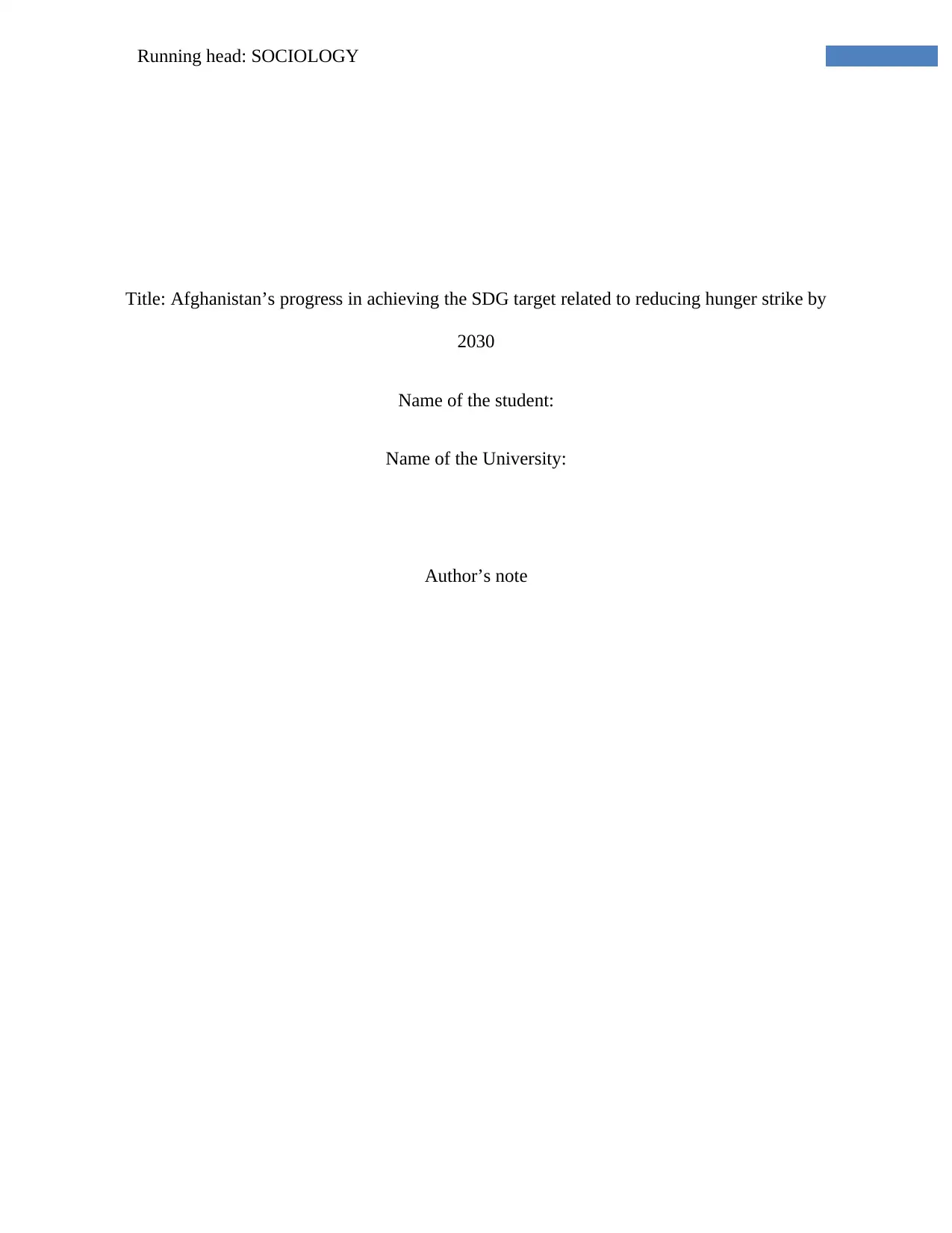
Running head: SOCIOLOGY
Title: Afghanistan’s progress in achieving the SDG target related to reducing hunger strike by
2030
Name of the student:
Name of the University:
Author’s note
Title: Afghanistan’s progress in achieving the SDG target related to reducing hunger strike by
2030
Name of the student:
Name of the University:
Author’s note
Paraphrase This Document
Need a fresh take? Get an instant paraphrase of this document with our AI Paraphraser
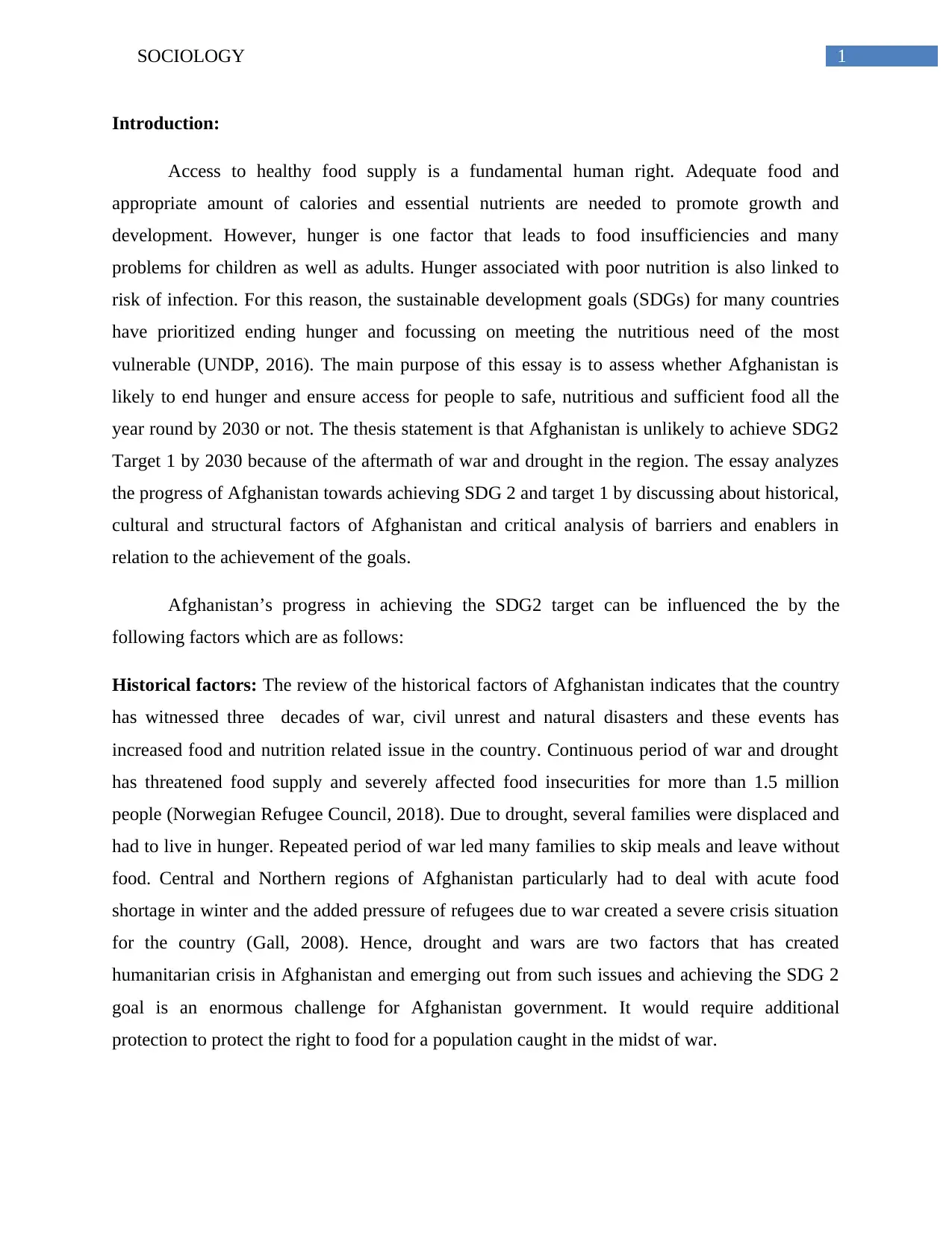
1SOCIOLOGY
Introduction:
Access to healthy food supply is a fundamental human right. Adequate food and
appropriate amount of calories and essential nutrients are needed to promote growth and
development. However, hunger is one factor that leads to food insufficiencies and many
problems for children as well as adults. Hunger associated with poor nutrition is also linked to
risk of infection. For this reason, the sustainable development goals (SDGs) for many countries
have prioritized ending hunger and focussing on meeting the nutritious need of the most
vulnerable (UNDP, 2016). The main purpose of this essay is to assess whether Afghanistan is
likely to end hunger and ensure access for people to safe, nutritious and sufficient food all the
year round by 2030 or not. The thesis statement is that Afghanistan is unlikely to achieve SDG2
Target 1 by 2030 because of the aftermath of war and drought in the region. The essay analyzes
the progress of Afghanistan towards achieving SDG 2 and target 1 by discussing about historical,
cultural and structural factors of Afghanistan and critical analysis of barriers and enablers in
relation to the achievement of the goals.
Afghanistan’s progress in achieving the SDG2 target can be influenced the by the
following factors which are as follows:
Historical factors: The review of the historical factors of Afghanistan indicates that the country
has witnessed three decades of war, civil unrest and natural disasters and these events has
increased food and nutrition related issue in the country. Continuous period of war and drought
has threatened food supply and severely affected food insecurities for more than 1.5 million
people (Norwegian Refugee Council, 2018). Due to drought, several families were displaced and
had to live in hunger. Repeated period of war led many families to skip meals and leave without
food. Central and Northern regions of Afghanistan particularly had to deal with acute food
shortage in winter and the added pressure of refugees due to war created a severe crisis situation
for the country (Gall, 2008). Hence, drought and wars are two factors that has created
humanitarian crisis in Afghanistan and emerging out from such issues and achieving the SDG 2
goal is an enormous challenge for Afghanistan government. It would require additional
protection to protect the right to food for a population caught in the midst of war.
Introduction:
Access to healthy food supply is a fundamental human right. Adequate food and
appropriate amount of calories and essential nutrients are needed to promote growth and
development. However, hunger is one factor that leads to food insufficiencies and many
problems for children as well as adults. Hunger associated with poor nutrition is also linked to
risk of infection. For this reason, the sustainable development goals (SDGs) for many countries
have prioritized ending hunger and focussing on meeting the nutritious need of the most
vulnerable (UNDP, 2016). The main purpose of this essay is to assess whether Afghanistan is
likely to end hunger and ensure access for people to safe, nutritious and sufficient food all the
year round by 2030 or not. The thesis statement is that Afghanistan is unlikely to achieve SDG2
Target 1 by 2030 because of the aftermath of war and drought in the region. The essay analyzes
the progress of Afghanistan towards achieving SDG 2 and target 1 by discussing about historical,
cultural and structural factors of Afghanistan and critical analysis of barriers and enablers in
relation to the achievement of the goals.
Afghanistan’s progress in achieving the SDG2 target can be influenced the by the
following factors which are as follows:
Historical factors: The review of the historical factors of Afghanistan indicates that the country
has witnessed three decades of war, civil unrest and natural disasters and these events has
increased food and nutrition related issue in the country. Continuous period of war and drought
has threatened food supply and severely affected food insecurities for more than 1.5 million
people (Norwegian Refugee Council, 2018). Due to drought, several families were displaced and
had to live in hunger. Repeated period of war led many families to skip meals and leave without
food. Central and Northern regions of Afghanistan particularly had to deal with acute food
shortage in winter and the added pressure of refugees due to war created a severe crisis situation
for the country (Gall, 2008). Hence, drought and wars are two factors that has created
humanitarian crisis in Afghanistan and emerging out from such issues and achieving the SDG 2
goal is an enormous challenge for Afghanistan government. It would require additional
protection to protect the right to food for a population caught in the midst of war.

2SOCIOLOGY
Cultural factors: Cultural norms are one factor that increases risk of discriminatory practice
while planning to end hunger in Afghanistan. Several food aid programmes has been
implemented in villages like Bagdah and Kas so that food aid reaches the poorest families.
Though the government of Afghanistan has committed to achieving SDG goal 2 (Zero hunger),
however the country faces numerous challenges in meeting the target because of gender
disparities. During the Taliban rule, the women were subjected to many atrocities and they were
not allowed to move freely. Because of cultural norms, they were married off in younger age
than 15 and they lacked education on properly meeting nutritional needs of their children
(Walton, 2016). Hence, as the right to education and right to work for women have been
influenced by gender disparities in Afghanistan, the regional cultural norm will act as a major
barrier in the involvement of women in agricultural processes and addressing food supply issues.
Low level of women engagement in education and employment will also undermine efforts to
improve nutritional needs of family (Arsala, 2016).
Structural factors:
Apart from historical and cultural factors, several other factors like transport,
infrastructure, land and rural/urban gap can affect the capability of Afghanistan government to
meet SDG2 target. This is said because food access is significantly affected in the country
because of poor condition of roads in Afghanistan. Majority of the roads in Afghanistan are in
poor condition that can affect food transportation process. The situation is exacerbated by
climate related and conflict related disturbances (Arsala, 2016). Hence, because of poor roads,
food is unlikely to reach the market and high food price can further make achievement of SDG 2
goal difficult for Afghanistan. Rural infrastructures needed for food transport such as electricity,
post harvest storage infrastructure, cold storage facilities and other facilities are also poor in
Afghanistan. Furthermore, poor economy and employment can further increase challenges for
citizens as meeting food and nutritional needs would become difficult (D’Souza & Jolliffe,
2016). Hence, many structural factors present in Afghanistan will halt the progress towards
SDG2 goals.
Critical analysis:
Cultural factors: Cultural norms are one factor that increases risk of discriminatory practice
while planning to end hunger in Afghanistan. Several food aid programmes has been
implemented in villages like Bagdah and Kas so that food aid reaches the poorest families.
Though the government of Afghanistan has committed to achieving SDG goal 2 (Zero hunger),
however the country faces numerous challenges in meeting the target because of gender
disparities. During the Taliban rule, the women were subjected to many atrocities and they were
not allowed to move freely. Because of cultural norms, they were married off in younger age
than 15 and they lacked education on properly meeting nutritional needs of their children
(Walton, 2016). Hence, as the right to education and right to work for women have been
influenced by gender disparities in Afghanistan, the regional cultural norm will act as a major
barrier in the involvement of women in agricultural processes and addressing food supply issues.
Low level of women engagement in education and employment will also undermine efforts to
improve nutritional needs of family (Arsala, 2016).
Structural factors:
Apart from historical and cultural factors, several other factors like transport,
infrastructure, land and rural/urban gap can affect the capability of Afghanistan government to
meet SDG2 target. This is said because food access is significantly affected in the country
because of poor condition of roads in Afghanistan. Majority of the roads in Afghanistan are in
poor condition that can affect food transportation process. The situation is exacerbated by
climate related and conflict related disturbances (Arsala, 2016). Hence, because of poor roads,
food is unlikely to reach the market and high food price can further make achievement of SDG 2
goal difficult for Afghanistan. Rural infrastructures needed for food transport such as electricity,
post harvest storage infrastructure, cold storage facilities and other facilities are also poor in
Afghanistan. Furthermore, poor economy and employment can further increase challenges for
citizens as meeting food and nutritional needs would become difficult (D’Souza & Jolliffe,
2016). Hence, many structural factors present in Afghanistan will halt the progress towards
SDG2 goals.
Critical analysis:
⊘ This is a preview!⊘
Do you want full access?
Subscribe today to unlock all pages.

Trusted by 1+ million students worldwide
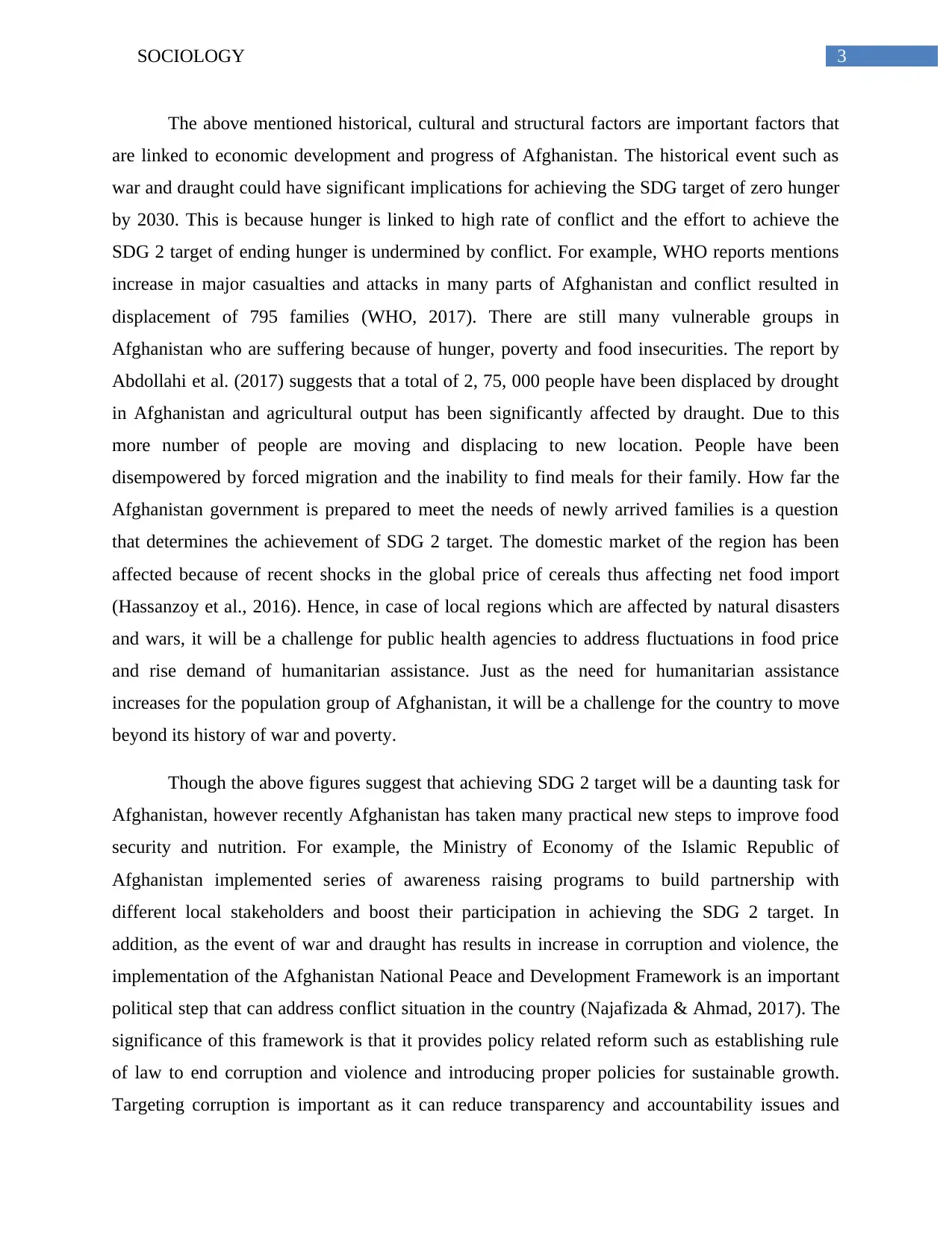
3SOCIOLOGY
The above mentioned historical, cultural and structural factors are important factors that
are linked to economic development and progress of Afghanistan. The historical event such as
war and draught could have significant implications for achieving the SDG target of zero hunger
by 2030. This is because hunger is linked to high rate of conflict and the effort to achieve the
SDG 2 target of ending hunger is undermined by conflict. For example, WHO reports mentions
increase in major casualties and attacks in many parts of Afghanistan and conflict resulted in
displacement of 795 families (WHO, 2017). There are still many vulnerable groups in
Afghanistan who are suffering because of hunger, poverty and food insecurities. The report by
Abdollahi et al. (2017) suggests that a total of 2, 75, 000 people have been displaced by drought
in Afghanistan and agricultural output has been significantly affected by draught. Due to this
more number of people are moving and displacing to new location. People have been
disempowered by forced migration and the inability to find meals for their family. How far the
Afghanistan government is prepared to meet the needs of newly arrived families is a question
that determines the achievement of SDG 2 target. The domestic market of the region has been
affected because of recent shocks in the global price of cereals thus affecting net food import
(Hassanzoy et al., 2016). Hence, in case of local regions which are affected by natural disasters
and wars, it will be a challenge for public health agencies to address fluctuations in food price
and rise demand of humanitarian assistance. Just as the need for humanitarian assistance
increases for the population group of Afghanistan, it will be a challenge for the country to move
beyond its history of war and poverty.
Though the above figures suggest that achieving SDG 2 target will be a daunting task for
Afghanistan, however recently Afghanistan has taken many practical new steps to improve food
security and nutrition. For example, the Ministry of Economy of the Islamic Republic of
Afghanistan implemented series of awareness raising programs to build partnership with
different local stakeholders and boost their participation in achieving the SDG 2 target. In
addition, as the event of war and draught has results in increase in corruption and violence, the
implementation of the Afghanistan National Peace and Development Framework is an important
political step that can address conflict situation in the country (Najafizada & Ahmad, 2017). The
significance of this framework is that it provides policy related reform such as establishing rule
of law to end corruption and violence and introducing proper policies for sustainable growth.
Targeting corruption is important as it can reduce transparency and accountability issues and
The above mentioned historical, cultural and structural factors are important factors that
are linked to economic development and progress of Afghanistan. The historical event such as
war and draught could have significant implications for achieving the SDG target of zero hunger
by 2030. This is because hunger is linked to high rate of conflict and the effort to achieve the
SDG 2 target of ending hunger is undermined by conflict. For example, WHO reports mentions
increase in major casualties and attacks in many parts of Afghanistan and conflict resulted in
displacement of 795 families (WHO, 2017). There are still many vulnerable groups in
Afghanistan who are suffering because of hunger, poverty and food insecurities. The report by
Abdollahi et al. (2017) suggests that a total of 2, 75, 000 people have been displaced by drought
in Afghanistan and agricultural output has been significantly affected by draught. Due to this
more number of people are moving and displacing to new location. People have been
disempowered by forced migration and the inability to find meals for their family. How far the
Afghanistan government is prepared to meet the needs of newly arrived families is a question
that determines the achievement of SDG 2 target. The domestic market of the region has been
affected because of recent shocks in the global price of cereals thus affecting net food import
(Hassanzoy et al., 2016). Hence, in case of local regions which are affected by natural disasters
and wars, it will be a challenge for public health agencies to address fluctuations in food price
and rise demand of humanitarian assistance. Just as the need for humanitarian assistance
increases for the population group of Afghanistan, it will be a challenge for the country to move
beyond its history of war and poverty.
Though the above figures suggest that achieving SDG 2 target will be a daunting task for
Afghanistan, however recently Afghanistan has taken many practical new steps to improve food
security and nutrition. For example, the Ministry of Economy of the Islamic Republic of
Afghanistan implemented series of awareness raising programs to build partnership with
different local stakeholders and boost their participation in achieving the SDG 2 target. In
addition, as the event of war and draught has results in increase in corruption and violence, the
implementation of the Afghanistan National Peace and Development Framework is an important
political step that can address conflict situation in the country (Najafizada & Ahmad, 2017). The
significance of this framework is that it provides policy related reform such as establishing rule
of law to end corruption and violence and introducing proper policies for sustainable growth.
Targeting corruption is important as it can reduce transparency and accountability issues and
Paraphrase This Document
Need a fresh take? Get an instant paraphrase of this document with our AI Paraphraser

4SOCIOLOGY
accelerate response towards food security and nutrition needs in the country. Hence, policy
related reforms and addressing systemic barriers are corruption is vital for the progress of the
country.
Apart from the fragile ecosystem of Afghanistan, which makes it highly vulnerable to
climate change and natural disasters, another major barrier to ending hunger in the region
includes gender disparities and lack of engagement of women in the workforce.
Shayan (2015) argues that most girls in Afghanistan are deprived of educational opportunities.
The statistics by the Ministry of Education in the country suggest that very few females attend
schools and colleges compared to males. Furthermore, marriage at early age and the dominance
of male prevent women from getting employment too. This cultural factor can seriously
undermine efforts to provide jobs to citizens to meet their food and nutrition needs. In view of
this challenge, one positive story is the inclusion of gender equality in many health promotion
initiatives. One example of such program is the Afghanistan Girl’s Education Initiative (AGEI)
whose key objectives were to strengthen national political commitment to improve the situation
of girl’s education and implement strategies to increase enrolment and retention of girls (United
Nations Girl’s Education Initiative, 2008).The outcome of the initiative is understood from the
fact that the gender parity index in GER score for Afghanistan is 0.70. Hence, though the girls’
participation in education has improved, they are still facing challenges because of poor access to
schools (Arsala, 2016). Hence, a lot needs to be done even now.
Recommendation:
Based on the review of barriers that would affect Afghanistan’s capability to meet SDG
target of zero hunger, the following recommendation is proposed to achieve the SDG 2 target:
It is recommended to take actions in the area of increasing economic development
opportunities for Afghan women so that women are empowered and they play a role in
addressing employment issues and take part in agricultural related activities.
As providing food assistance will be a major challenge because of displacement of large
number of people to natural disaster, it is recommended to invest in sustainable
agricultural systems and practices and enhance water governance to manage competing
food demands.
accelerate response towards food security and nutrition needs in the country. Hence, policy
related reforms and addressing systemic barriers are corruption is vital for the progress of the
country.
Apart from the fragile ecosystem of Afghanistan, which makes it highly vulnerable to
climate change and natural disasters, another major barrier to ending hunger in the region
includes gender disparities and lack of engagement of women in the workforce.
Shayan (2015) argues that most girls in Afghanistan are deprived of educational opportunities.
The statistics by the Ministry of Education in the country suggest that very few females attend
schools and colleges compared to males. Furthermore, marriage at early age and the dominance
of male prevent women from getting employment too. This cultural factor can seriously
undermine efforts to provide jobs to citizens to meet their food and nutrition needs. In view of
this challenge, one positive story is the inclusion of gender equality in many health promotion
initiatives. One example of such program is the Afghanistan Girl’s Education Initiative (AGEI)
whose key objectives were to strengthen national political commitment to improve the situation
of girl’s education and implement strategies to increase enrolment and retention of girls (United
Nations Girl’s Education Initiative, 2008).The outcome of the initiative is understood from the
fact that the gender parity index in GER score for Afghanistan is 0.70. Hence, though the girls’
participation in education has improved, they are still facing challenges because of poor access to
schools (Arsala, 2016). Hence, a lot needs to be done even now.
Recommendation:
Based on the review of barriers that would affect Afghanistan’s capability to meet SDG
target of zero hunger, the following recommendation is proposed to achieve the SDG 2 target:
It is recommended to take actions in the area of increasing economic development
opportunities for Afghan women so that women are empowered and they play a role in
addressing employment issues and take part in agricultural related activities.
As providing food assistance will be a major challenge because of displacement of large
number of people to natural disaster, it is recommended to invest in sustainable
agricultural systems and practices and enhance water governance to manage competing
food demands.
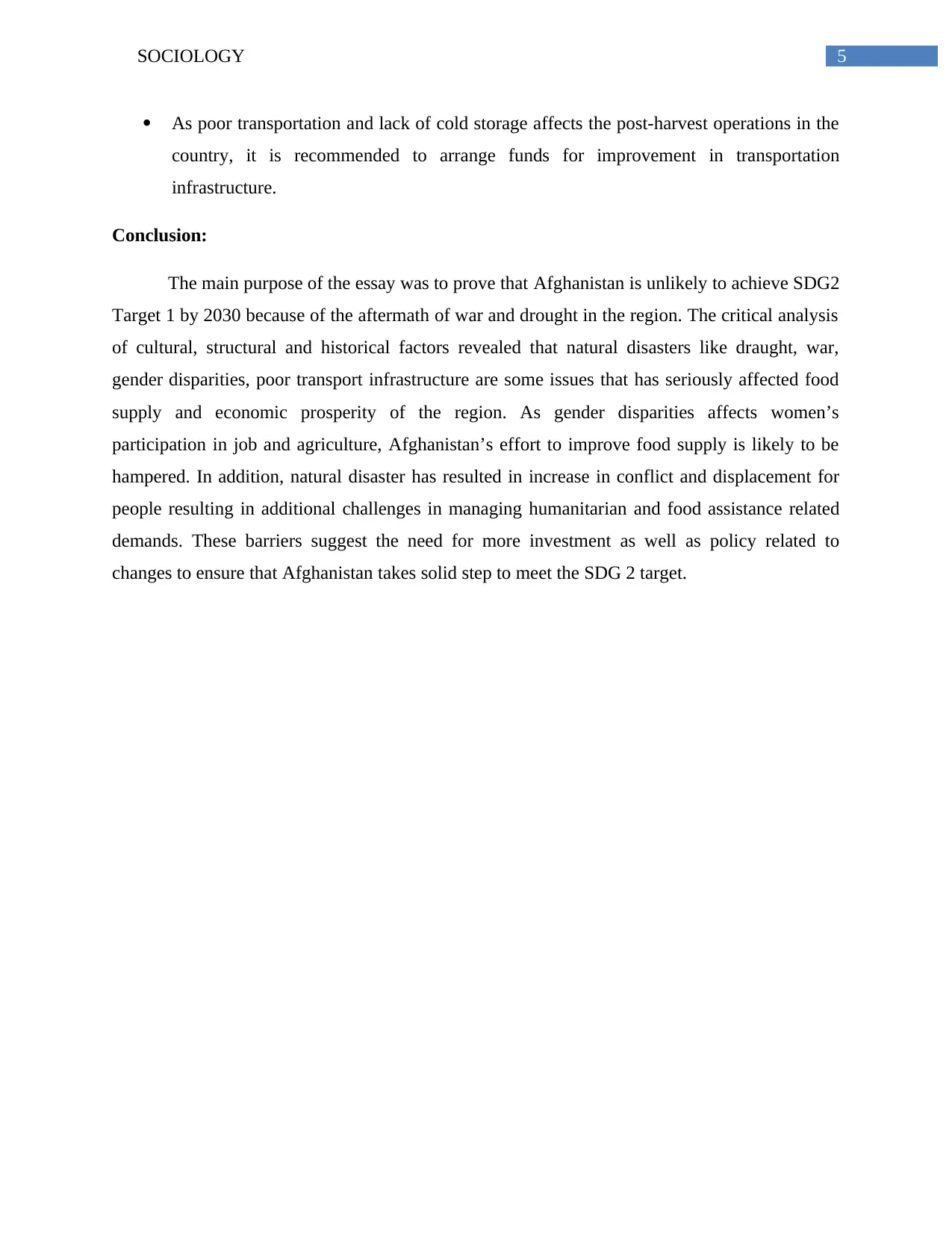
5SOCIOLOGY
As poor transportation and lack of cold storage affects the post-harvest operations in the
country, it is recommended to arrange funds for improvement in transportation
infrastructure.
Conclusion:
The main purpose of the essay was to prove that Afghanistan is unlikely to achieve SDG2
Target 1 by 2030 because of the aftermath of war and drought in the region. The critical analysis
of cultural, structural and historical factors revealed that natural disasters like draught, war,
gender disparities, poor transport infrastructure are some issues that has seriously affected food
supply and economic prosperity of the region. As gender disparities affects women’s
participation in job and agriculture, Afghanistan’s effort to improve food supply is likely to be
hampered. In addition, natural disaster has resulted in increase in conflict and displacement for
people resulting in additional challenges in managing humanitarian and food assistance related
demands. These barriers suggest the need for more investment as well as policy related to
changes to ensure that Afghanistan takes solid step to meet the SDG 2 target.
As poor transportation and lack of cold storage affects the post-harvest operations in the
country, it is recommended to arrange funds for improvement in transportation
infrastructure.
Conclusion:
The main purpose of the essay was to prove that Afghanistan is unlikely to achieve SDG2
Target 1 by 2030 because of the aftermath of war and drought in the region. The critical analysis
of cultural, structural and historical factors revealed that natural disasters like draught, war,
gender disparities, poor transport infrastructure are some issues that has seriously affected food
supply and economic prosperity of the region. As gender disparities affects women’s
participation in job and agriculture, Afghanistan’s effort to improve food supply is likely to be
hampered. In addition, natural disaster has resulted in increase in conflict and displacement for
people resulting in additional challenges in managing humanitarian and food assistance related
demands. These barriers suggest the need for more investment as well as policy related to
changes to ensure that Afghanistan takes solid step to meet the SDG 2 target.
⊘ This is a preview!⊘
Do you want full access?
Subscribe today to unlock all pages.

Trusted by 1+ million students worldwide
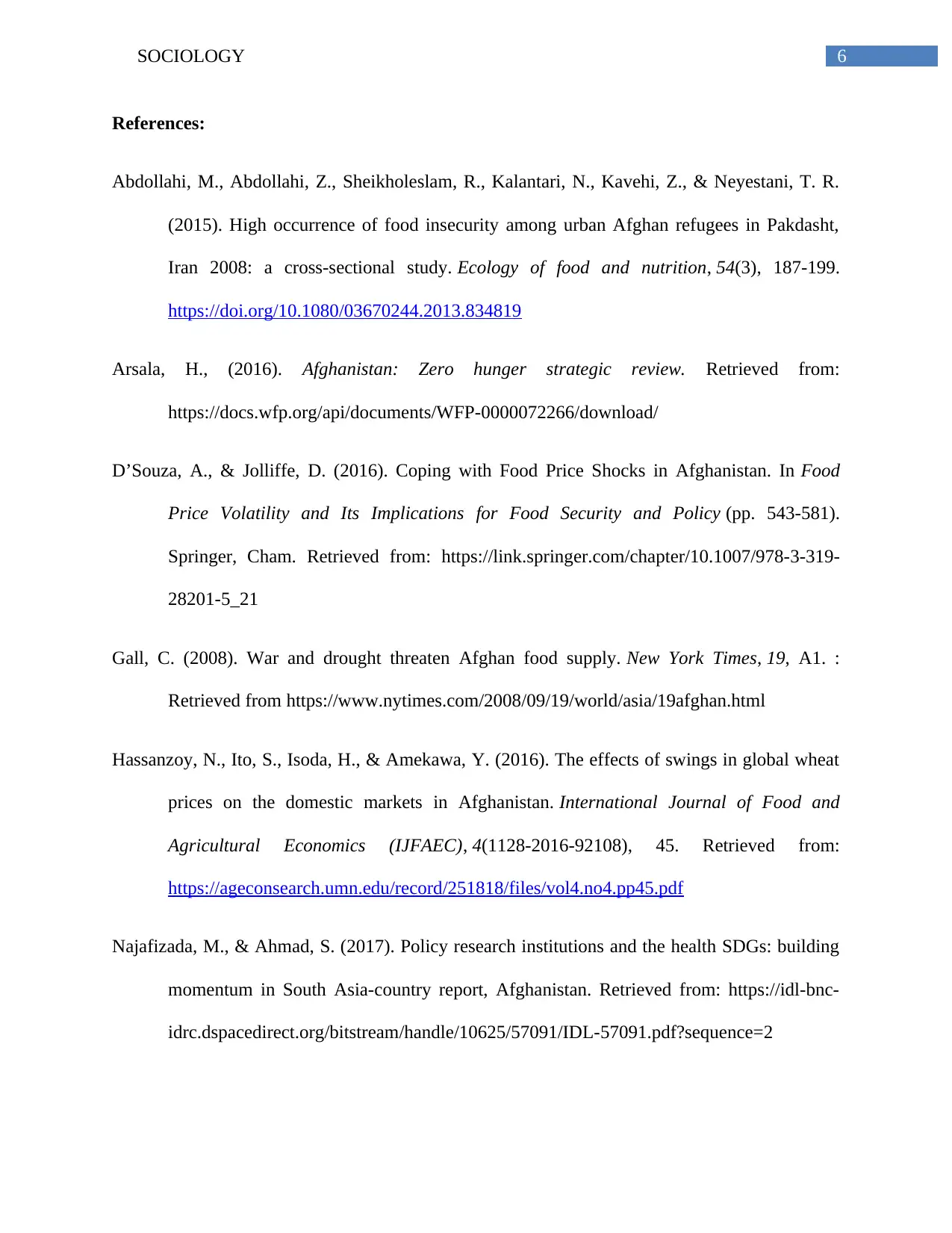
6SOCIOLOGY
References:
Abdollahi, M., Abdollahi, Z., Sheikholeslam, R., Kalantari, N., Kavehi, Z., & Neyestani, T. R.
(2015). High occurrence of food insecurity among urban Afghan refugees in Pakdasht,
Iran 2008: a cross-sectional study. Ecology of food and nutrition, 54(3), 187-199.
https://doi.org/10.1080/03670244.2013.834819
Arsala, H., (2016). Afghanistan: Zero hunger strategic review. Retrieved from:
https://docs.wfp.org/api/documents/WFP-0000072266/download/
D’Souza, A., & Jolliffe, D. (2016). Coping with Food Price Shocks in Afghanistan. In Food
Price Volatility and Its Implications for Food Security and Policy (pp. 543-581).
Springer, Cham. Retrieved from: https://link.springer.com/chapter/10.1007/978-3-319-
28201-5_21
Gall, C. (2008). War and drought threaten Afghan food supply. New York Times, 19, A1. :
Retrieved from https://www.nytimes.com/2008/09/19/world/asia/19afghan.html
Hassanzoy, N., Ito, S., Isoda, H., & Amekawa, Y. (2016). The effects of swings in global wheat
prices on the domestic markets in Afghanistan. International Journal of Food and
Agricultural Economics (IJFAEC), 4(1128-2016-92108), 45. Retrieved from:
https://ageconsearch.umn.edu/record/251818/files/vol4.no4.pp45.pdf
Najafizada, M., & Ahmad, S. (2017). Policy research institutions and the health SDGs: building
momentum in South Asia-country report, Afghanistan. Retrieved from: https://idl-bnc-
idrc.dspacedirect.org/bitstream/handle/10625/57091/IDL-57091.pdf?sequence=2
References:
Abdollahi, M., Abdollahi, Z., Sheikholeslam, R., Kalantari, N., Kavehi, Z., & Neyestani, T. R.
(2015). High occurrence of food insecurity among urban Afghan refugees in Pakdasht,
Iran 2008: a cross-sectional study. Ecology of food and nutrition, 54(3), 187-199.
https://doi.org/10.1080/03670244.2013.834819
Arsala, H., (2016). Afghanistan: Zero hunger strategic review. Retrieved from:
https://docs.wfp.org/api/documents/WFP-0000072266/download/
D’Souza, A., & Jolliffe, D. (2016). Coping with Food Price Shocks in Afghanistan. In Food
Price Volatility and Its Implications for Food Security and Policy (pp. 543-581).
Springer, Cham. Retrieved from: https://link.springer.com/chapter/10.1007/978-3-319-
28201-5_21
Gall, C. (2008). War and drought threaten Afghan food supply. New York Times, 19, A1. :
Retrieved from https://www.nytimes.com/2008/09/19/world/asia/19afghan.html
Hassanzoy, N., Ito, S., Isoda, H., & Amekawa, Y. (2016). The effects of swings in global wheat
prices on the domestic markets in Afghanistan. International Journal of Food and
Agricultural Economics (IJFAEC), 4(1128-2016-92108), 45. Retrieved from:
https://ageconsearch.umn.edu/record/251818/files/vol4.no4.pp45.pdf
Najafizada, M., & Ahmad, S. (2017). Policy research institutions and the health SDGs: building
momentum in South Asia-country report, Afghanistan. Retrieved from: https://idl-bnc-
idrc.dspacedirect.org/bitstream/handle/10625/57091/IDL-57091.pdf?sequence=2
Paraphrase This Document
Need a fresh take? Get an instant paraphrase of this document with our AI Paraphraser
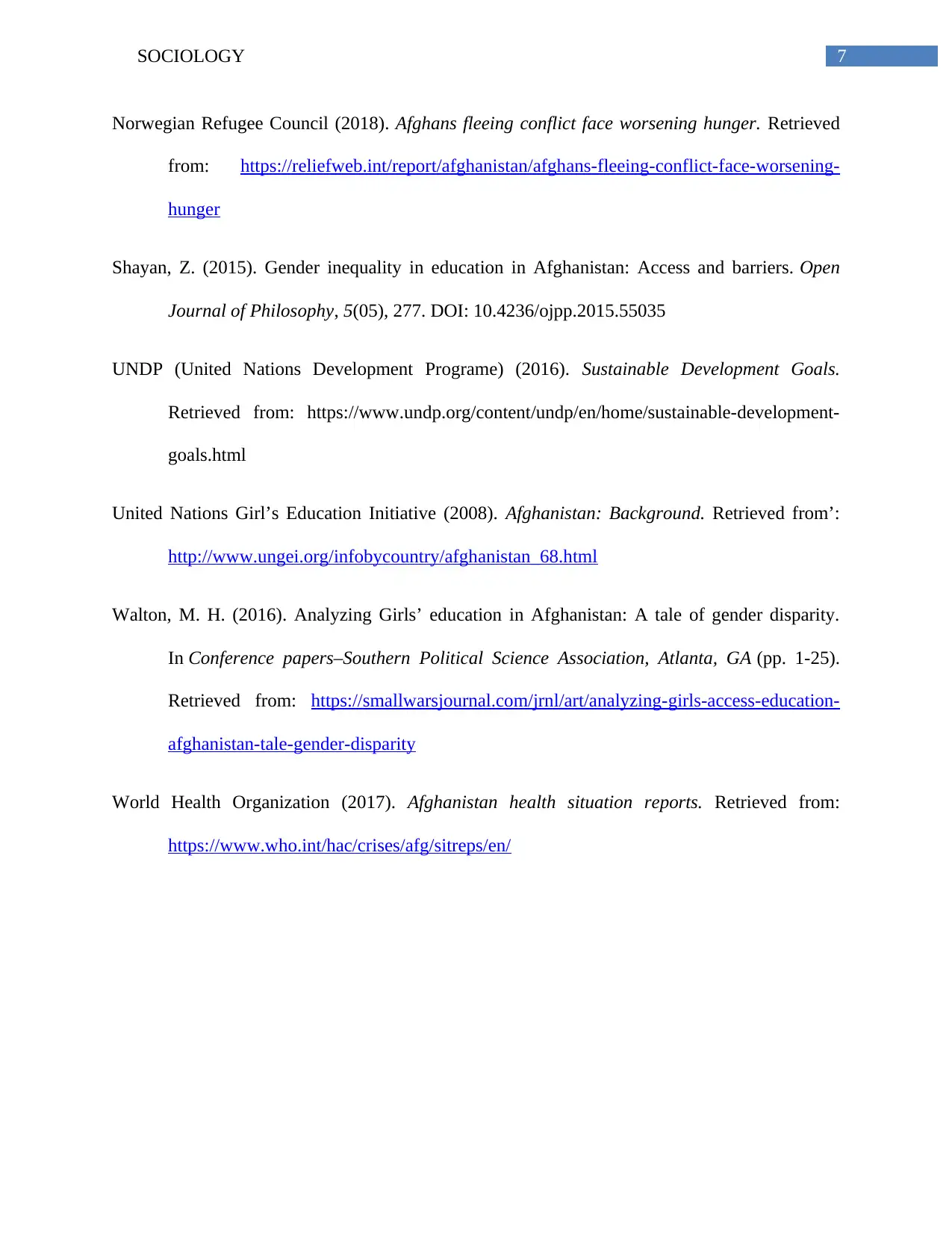
7SOCIOLOGY
Norwegian Refugee Council (2018). Afghans fleeing conflict face worsening hunger. Retrieved
from: https://reliefweb.int/report/afghanistan/afghans-fleeing-conflict-face-worsening-
hunger
Shayan, Z. (2015). Gender inequality in education in Afghanistan: Access and barriers. Open
Journal of Philosophy, 5(05), 277. DOI: 10.4236/ojpp.2015.55035
UNDP (United Nations Development Programe) (2016). Sustainable Development Goals.
Retrieved from: https://www.undp.org/content/undp/en/home/sustainable-development-
goals.html
United Nations Girl’s Education Initiative (2008). Afghanistan: Background. Retrieved from’:
http://www.ungei.org/infobycountry/afghanistan_68.html
Walton, M. H. (2016). Analyzing Girls’ education in Afghanistan: A tale of gender disparity.
In Conference papers–Southern Political Science Association, Atlanta, GA (pp. 1-25).
Retrieved from: https://smallwarsjournal.com/jrnl/art/analyzing-girls-access-education-
afghanistan-tale-gender-disparity
World Health Organization (2017). Afghanistan health situation reports. Retrieved from:
https://www.who.int/hac/crises/afg/sitreps/en/
Norwegian Refugee Council (2018). Afghans fleeing conflict face worsening hunger. Retrieved
from: https://reliefweb.int/report/afghanistan/afghans-fleeing-conflict-face-worsening-
hunger
Shayan, Z. (2015). Gender inequality in education in Afghanistan: Access and barriers. Open
Journal of Philosophy, 5(05), 277. DOI: 10.4236/ojpp.2015.55035
UNDP (United Nations Development Programe) (2016). Sustainable Development Goals.
Retrieved from: https://www.undp.org/content/undp/en/home/sustainable-development-
goals.html
United Nations Girl’s Education Initiative (2008). Afghanistan: Background. Retrieved from’:
http://www.ungei.org/infobycountry/afghanistan_68.html
Walton, M. H. (2016). Analyzing Girls’ education in Afghanistan: A tale of gender disparity.
In Conference papers–Southern Political Science Association, Atlanta, GA (pp. 1-25).
Retrieved from: https://smallwarsjournal.com/jrnl/art/analyzing-girls-access-education-
afghanistan-tale-gender-disparity
World Health Organization (2017). Afghanistan health situation reports. Retrieved from:
https://www.who.int/hac/crises/afg/sitreps/en/
1 out of 8
Related Documents
Your All-in-One AI-Powered Toolkit for Academic Success.
+13062052269
info@desklib.com
Available 24*7 on WhatsApp / Email
![[object Object]](/_next/static/media/star-bottom.7253800d.svg)
Unlock your academic potential
Copyright © 2020–2025 A2Z Services. All Rights Reserved. Developed and managed by ZUCOL.





